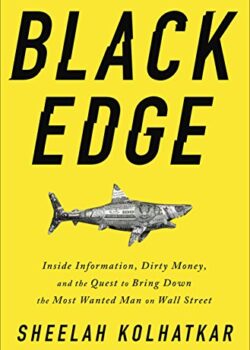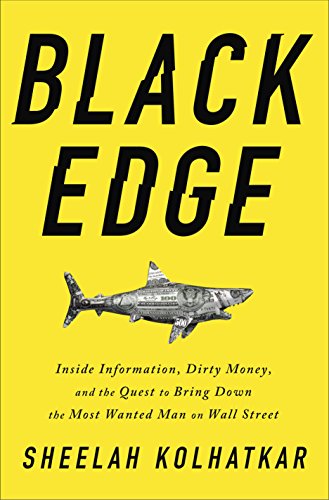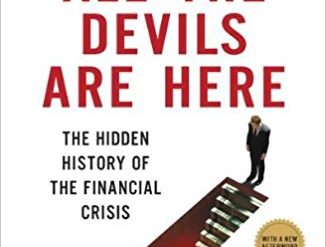
If you want to understand the depth of corruption that prevails on Wall Street, a good place to start is New Yorker staff writer Sheelah Kolhatkar‘s admirable new book, Black Edge: Inside Information, Dirty Money, and the Quest to Bring Down the Most Wanted Man on Wall Street.
Estimated reading time: 7 minutes
A loathsome human being
The central character is this superb piece of investigative journalism is Steven A. Cohen, the founder of a hedge fund named SAC Capital Advisors. Cohen is clearly a loathsome human being—obsessed with greed, contemptuous of the law, and ruthless beyond compare. For example, here is an eyewitness account of a statement he made to the traders at his fund while in the midst of ugly divorce proceedings with his first wife. “‘I just got ripped off by my wife,’ he said . . . ‘I’m going to make it all back by cutting your payouts.'” This was not bluster: he actually did it, reducing their compensation from 30% of profits to 25% and increasing his own correspondingly. The author also notes that “he went out of his way to abuse people and belittle them.”
Black Edge: Inside Information, Dirty Money, and the Quest to Bring Down the Most Wanted Man on Wall Street by Sheelah Kolhatkar (2017) 370 pages ★★★★★
However, Cohen is also undeniably brilliant. Occasionally he’s referred to as the greatest stock trader in Wall Street history. Cohen’s instinct is apparently matchless. Obviously, too, he was diabolically clever in shielding himself from responsibility for the illegal actions he forced his employees to take. After decade-long investigations by the FBI and the SEC, Cohen was forced to close down his hedge fund, but he escaped from prosecution, paying only a fine that was modest on the scale of his wealth. (Cohen is now estimated to have a net worth of $13 billion. That’s billion with a B.) Kolhatkar makes clear that despite his undisputed brilliance as a trader, he broke insider trading laws and regulations to gain most of his fortune.
How hedge funds operate
It helps to understand what hedge funds really are and what they do. Originally, hedge funds were designed to “hedge” or protect the assets of extremely wealthy individuals, pension funds, and other high-net-worth institutions. You can find an explanation of classic hedging strategies in plain English here. Over time, however, as the industry became more competitive, hedge fund managers increasingly gravitated away from investing and took up trading, eventually even trading in and out of stocks over fractions of a second. Kolharkar explains that “the name hedge fund lost any connection to the careful strategy that had given such funds their name and came to stand, instead, for unregulated investment firms that essentially did whatever they wanted.”
The role of hedge funds in the economy
Don’t make the mistake of thinking that hedge funds like Steve Cohen’s invested in the stock market like Main Street’s typical small investor. Kolhatkar quotes an email from one of Cohen’s traders three weeks before earnings of computer manufacturer Dell, Inc. were to be announced: “‘gm looking 17.5% vs. street 18.3%. Doesn’t sound good.'” In translation this jargon would read “Dell’s gross margin is anticipated by insiders to be 17.5% in the most recent quarter as opposed to estimates by Wall Street analysts of 18.3%.”
In other words, this trivial difference in earnings for Dell for a three-month period would cause hundreds of millions, perhaps billions of dollars worth of the company’s shares to be sold, thus depressing its stock price. This means, of course, that Dell’s board of directors and top executives would do everything within their power to reverse that decline in the next quarter, regardless of the long-term consequences to the company, its employees, its investor-stockholders, and the economy at large. In this way, Wall Street distorts the American (and ultimately the world) economy. That makes no sense at all except for the gamblers who engage in day-to-day and minute-to-minute stock trading.
Hedge funds are not just a minor problem
Given the complexity of the financial markets, it’s too easy to imagine that hedge funds are just one minor element of the problems they pose for the economy. “By 2015,” Kolhatkar writes, “hedge funds controlled almost $3 trillion in assets around the world and were a driving force behind the extreme wealth disequilibrium of the early twenty-first century.” A couple of numbers convey a sense of the magnitude of the problem caused by hedge funds: as Forbes magazine writes, “In total, the 25 highest-earning hedge fund managers and traders made a combined $12 billion in 2015.” The top earner, James Simons, logged an estimated total of $1.65 billion. In one year! The average top manager of a hedge fund earned nearly half a billion dollars that year.
Should there be an upper limit on compensation?
I recognize that many Americans are convinced there should be no upper limit on income. I disagree because I do not believe that anyone whatsoever could possibly provide enough benefit to society to warrant compensation of half a billion dollars a year—and because I know that such high levels of income are only possible because the U.S. tax laws are rigged to favor the superrich and disadvantage the rest of us. To grasp how much money these numbers represent, consider this: in 2015, the same year cited by Forbes, the single highest-paid corporate executive earned $156 million. Thus, the average top-25 hedge fund CEO received more than three times as much money. And I know no one who would pretend that $156 million represents fair compensation for anyone for a single year’s work.
Seeking a “black edge”
In trading, hedge fund managers routinely came to seek out an information “edge” to reduce or eliminate the risk in their trades. As Kolhatkar explains, a “black edge” is information obtained in obviously illegal ways, such as paying a company insider for advance word of important developments in that company’s fortunes. “Gray edge [is] trickier. Any analyst doing his job well would come across this sort of information all the time. For example, an investor-relations person at a company might say something like ‘Yeah, things are trending a little lower than we thought . . .'” This may or may not constitute insider information. The lawyers decide. “White edge,” of course, is “readily available information that anyone could find in a research report or a public document.” Much, perhaps nearly all, the information on which Steve Cohen based his trades was on the “black edge.”
Hedge funds and the corruption of the American economy
Kolhatkar did not pick Cohen and SAC Capital Advisors arbitrarily. The fund posted average gains of 30 percent per year over 20 years. Anyone who has investment experience knows that it’s virtually impossible to earn such high profits year after year for such a long period entirely by legal means. However, SAC Capital Advisors was in many ways typical of the hedge fund industry. Kolhatkar again: “When one trader was asked if he knew of any that didn’t traffic in inside information, he said: ‘No, they would never survive.'”
The corruption fostered by the hedge fund industry extended far beyond Wall Street. In their scramble for insider information to give themselves a black edge, hedge fund managers bought off doctors throughout the country. “In 2005,” the author notes, “Journal of the American Medical Association published a finding that almost 10 percent of the doctors in the United States had paid ties to Wall Street investors . . . The unofficial number was probably much higher.”
It’s difficult to imagine how any public official acquainted with these facts could seriously contend that Wall Street should be deregulated. Yet the elected leadership of the United States seems hell-bent on doing just that.
About the author
Sheilah Kolhatkar was recently interviewed by the New York Times Book Review. The interviewer notes that she “worked in the late 1990s and early 2000s as an analyst at a couple of small hedge funds. . .” As she told the interviewer on the phone, even then she “heard people talking about the trader Steven A. Cohen and the stellar returns at SAC Capital, which he began in 1992.” Kolhatkar explained why she left the hedge fund industry after the dot-com bust and went into print journalism instead. “I could not handle the stress of making imperfect decisions based on incomplete information with other people’s money . . . I didn’t have the personality for it.” Before signing on with The New Yorker in 2016, Kolhatkar was a features editor and national correspondent at Bloomberg Businessweek.
For related reading
Like to read books about business? Check out My 10 favorite books about business history and Good books about finance and economics.
If you enjoy reading nonfiction in general, you might also enjoy:
- Science explained in 10 excellent popular books
- Great biographies I’ve reviewed: my 10 favorites
- Top 10 nonfiction books about politics
And you can always find my most popular reviews, and the most recent ones, on the Home Page.



























